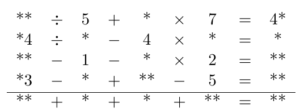Problems
Fred and George together with their mother were decorating the Christmas tree. So that they would not fight, their mother gave each brother the same number of decorations and branches. Fred tried to hang one decoration on each branch, but he needed one more branch for his last decoration. George tried to hang two toys on each branch, but one branch was empty. What do you think, how many branches and how many decorations did the mother give to her sons?
The farmer must transport across a river a wolf, a goat and a cabbage. The boat accommodates one person, and with him/her either a wolf, a goat, or a cabbage. If you leave the goat and the wolf unattended, the wolf will eat the goat. If you leave cabbage and goat without supervision, the goat will eat the cabbage. How can the farmer transport his cargo across the river?
Prove that the following facts are true for any graph:
a) The sum of degrees of all vertices is equal to twice the number of edges (and therefore it is even);
b) The number of vertices of odd degree is even.
There is a 12-litre barrel filled with beer, and two empty kegs of 5 and 8 litres. Try using these kegs to:
a) divide the beer into two parts of 3 and 9 litres;
b) divide the beer into two equal parts.
A traveller rents a room in an inn for a week and offers the innkeeper a chain of seven silver links as payment – one link per day, with the condition that they will be payed everyday. The innkeeper agrees, with the condition that the traveller can only cut one of the links. How did the traveller manage to pay the innkeeper?
During a chess tournament, some of the players played an odd number of games. Prove that the number of such players is even.
In the rebus in the diagram below, the arithmetic operations are carried out from left to right (even though the brackets are not written).
For example, in the first row "\(** \div 5 + * \times 7 = 4*\)" is the same as "\(((** \div 5) +*) \times 7 = 4*\)". Each number in the last row is the sum of the numbers in the column above it. The result of each \(n\)-th row is equal to the sum of the first four numbers in the \(n\)-th column. All of the numbers in this rebus are non-zero and do not begin with a zero, however they could end with a zero. That is, 10 is allowed but not 01 or 0. Solve the rebus.

There are scales without weights and 3 identical in appearance coins, one of which is fake: it is lighter than the real ones (the real coins are of the same weight). How many weightings are needed to determine the counterfeit coin? Solve the same problem in the cases where there are 4 coins and 9 coins.
We have scales without weights and 3 identical in appearance coins. One of the coins is fake, and it is not known whether it is lighter or heavier than the real coins (note that all real coins are of the same weight). How many weighings are needed to determine the counterfeit coin? Solve the same problem in the cases where there are 4 coins and 9 coins.
Decode this rebus: replace the asterisks with numbers such that the equalities in each row are true and such that each number in the bottom row is equal to the sum of the numbers in the column above it.